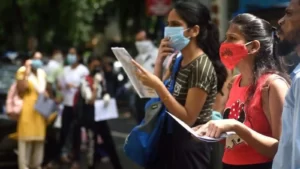
The observance of World Habitat Day, held on the first Monday of October, highlights the important global issue of urban housing and poverty, a challenge that is particularly acute in India. In 2023, under the theme “Resilient urban economies: Cities as catalysts of growth and recovery,” this day brought into focus the urgent need for affordable housing in rapidly urbanizing nations like India. With a significant portion of its population grappling with urban poverty, exacerbated by a severe shortage of affordable housing, India’s struggle is emblematic of a larger global crisis. This article explores the complex relationship between affordable housing and urban poverty in India, examining the efforts and policies aimed at addressing this pressing issue.
You Can Read Also: Largest & Smallest State / UT in India
Understanding Urban Poverty in India
Urban poverty in India is a multifaceted problem, characterized by a lack of access to basic services, including adequate housing. According to the 2011 Census of India, over 65 million people, or 17.4% of the urban population, live in slums. These areas, often lacking proper sanitation, water supply, and electricity, are a stark reminder of the urban housing crisis. The rapid urbanization of Indian cities has not been accompanied by a commensurate increase in affordable housing, leading to overcrowding and the proliferation of slums.
The Housing Crisis in Urban India
The challenge of providing affordable housing in India’s urban areas is daunting. A 2012 report by the Ministry of Housing and Urban Poverty Alleviation estimated an urban housing shortage of nearly 18.78 million units. The majority of this shortage affects economically weaker sections and low-income groups. High real estate prices and rental costs in cities like Mumbai, Delhi, and Bangalore push affordable housing out of reach for many, forcing them to live in inadequate conditions.
Governmental Schemes and Programs for Affordable Housing in India
1. Affordable Rental Housing Complexes (ARHCs) Scheme
• Launched: 2020
• Objective: To provide affordable rental housing to urban migrants/poor.
• Features:
• Conversion of existing government-funded vacant houses into ARHCs through Public-Private Partnerships.
• Incentives to private/public entities to develop ARHCs on their own available vacant land.
• Offering a sustainable, affordable rental housing solution for urban migrants/poor close to their workplace.
2. Pradhan Mantri Awas Yojana (PMAY)
• Launched: 2015
• Objective: To provide affordable housing to the urban poor by 2022.
• Components:
• In-situ Slum Redevelopment: Using land as a resource to provide houses to slum dwellers.
• Credit Linked Subsidy Scheme (CLSS): Interest subsidy for the purchase/construction/extension/improvement of a house.
• Affordable Housing in Partnership (AHP): Public-private partnership for affordable housing development.
• Beneficiary-led individual house construction/enhancements: Assistance to individuals to either construct new houses or enhance existing houses on their own.
• Target: Building 20 million affordable houses for the urban poor.
3. Atal Mission for Rejuvenation and Urban Transformation (AMRUT)
• Launched: 2015
• Objective: To provide basic services to households and build amenities in cities.
• Features: Focuses on water supply, sewerage facilities, urban transport, and affordable housing.
4. Deendayal Antyodaya Yojana – National Urban Livelihoods Mission (DAY-NULM)
• Launched: 2013
• Objective: To reduce poverty and vulnerability of urban poor households by enabling them to access gainful self-employment and skilled wage employment opportunities.
• Components:
• Employment through Skills Training and Placement (EST&P).
• Social Mobilization and Institution Development.
• Subsidy to urban street vendors through a Micro-Enterprise Development program.
• Shelter for Urban Homeless.
5. Smart Cities Mission
• Launched: 2015
• Objective: To promote sustainable and inclusive cities that provide core infrastructure, a decent quality of life to its citizens, and a clean and sustainable environment.
• Features:
• Development of new and existing areas as ‘Smart Cities’ with upgraded infrastructure, including affordable housing.
• Use of smart solutions to enhance the livability, workability, and sustainability of urban areas.
6. Rajiv Awas Yojana (RAY)
• Launched: 2011
• Objective: To promote a slum-free India and to encourage states/UTs to tackle the issue of slums in a definitive manner.
• Features:
• Provision of shelter with basic civic infrastructure like water supply, sewerage, roads, and electricity.
• Formal integration of slum dwellers into the urban fabric.
• Encouraging states/UTs to bring institutional and legal changes to redress the failures of the formal system that lead to the creation of slums.
These schemes represent a comprehensive approach by the Indian government to address the affordable housing crisis and urban poverty. Each program targets different aspects of the issue, from slum redevelopment to providing rental housing solutions for urban migrants.
You Must Read: PM Kisan Samman Nidhi Yojana
Link Between Housing and Poverty in India
In India, the lack of affordable housing is intricately linked to the cycle of poverty. The consequences of inadequate housing extend beyond the physical structure, affecting health, education, and economic opportunities:
• Health Impacts: Poor housing conditions, often characterized by overcrowding and lack of sanitation, lead to health issues like respiratory problems and infectious diseases.
• Educational Challenges: Children living in inadequate housing conditions struggle with issues like lack of space for studying and frequent relocations, adversely affecting their educational performance.
• Economic Constraints: High housing costs force families to allocate a significant portion of their income to rent, limiting their ability to spend on other essentials like nutrition and healthcare.
Innovative Solutions and Success Stories
In addition to governmental efforts, several innovative solutions have emerged in India to address the affordable housing challenge:
1. Community-Led Housing Projects: Initiatives where slum dwellers are actively involved in the planning and construction of their homes, fostering a sense of ownership and community.
2. Use of Sustainable and Low-Cost Building Materials: Innovations in construction technology, such as using eco-friendly and locally sourced materials, reduce the cost of building homes.
3. Public-Private Partnerships (PPPs): Collaboration between the government and private sector entities has led to the development of affordable housing projects with improved amenities.
Success Stories:
• Indore’s Slum Rehabilitation Project: A notable example where slum dwellers were relocated to well-constructed houses with essential amenities, significantly improving their living conditions.
• Kerala’s LIFE Mission: An initiative aimed at providing safe and adequate housing for all, particularly the homeless and those living in precarious conditions.
You Can Read Also: National/Official Languages in India
To conclude, the issue of affordable housing in urban India is a critical factor in the fight against poverty. While the challenges are significant, the concerted efforts of the government, along with innovative approaches and community participation, offer hope. Ensuring access to safe, affordable housing is not just about providing shelter; it’s about breaking the cycle of poverty, improving health and education outcomes, and paving the way for a more equitable society. As India continues to urbanize at a rapid pace, the commitment to affordable housing will play a pivotal role in shaping the future of its cities and the well-being of its citizens.





